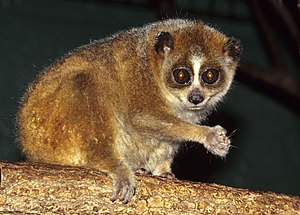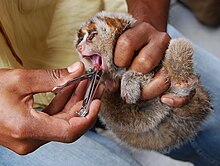Slow Loris
| Slow Loris | ||||||||||||
|---|---|---|---|---|---|---|---|---|---|---|---|---|

Pygmy Lory ( Nycticebus pygmaeus ) |
||||||||||||
| Systematics | ||||||||||||
|
||||||||||||
| Scientific name | ||||||||||||
| Nycticebus | ||||||||||||
| E. Geoffroy , 1812 |
The slow loris ( Nycticebus ) are a primate genus in the family of Loris (Lorisidae). They are nocturnal, tree-dwelling animals that live in Southeast Asia . Depending on the system, there are three to eight types.
features
Slow loris are built much stockier than the closely related slim loris . They reach a head body length of 18 to 38 centimeters, there is no tail. The weight is 0.3 to 2 kilograms depending on the species, the pygmy loris is significantly smaller than the other species. The limbs are strong, the thumbs and first toes are opposable , the second fingers of the hands are receded. These modifications of the hands enable a strong, almost unbreakable grip around the branches. With the exception of the second toes, which have the cleaning claws typical of wet-nosed monkeys , the fingers and toes have nails.
The number of thoracic and sacral vertebrae is increased, which means that the animals can wind around the branches in a very agile manner. The fur is short and dense, its color varies from white-gray to red-brown, the underside is somewhat lighter. The eyes are large, round and directed forward, the ears are small, rounded and almost hidden in the fur.
Slow loris are one of the few poisonous mammals . A gland on the arm produces a secretion that, in conjunction with saliva, develops its toxicity. By licking themselves, slow lorises drive away a number of potential predators with the poison; but it can also be transmitted with bites.
distribution and habitat
Slow loris are native to Southeast Asia, their range extends from eastern India and southern China over the Malay Peninsula to Borneo and Java . Their habitat is rainforests and other forest forms, in the trees they are mostly in the crown region.
Lifestyle and diet
Like all lories, slow lorises are nocturnal tree dwellers. During the day they sleep on branches or curled up in the dense vegetation, at night they go in search of food. Their movements are slow and deliberate, they also make relatively few sounds.
Little is known about their social behavior. The males are territorial and defend their territory against other males, they either live solitary or in small family groups. They urinate on their hands and leave behind a scent trail on their forays that draws their conspecifics attention to their presence.
Slow loris are omnivores that mainly eat fruits and insects and sometimes tree sap. Other components of their diet are small vertebrates, eggs and various parts of plants. When hunting, they creep up to the prey with their slow movements, only to catch them in a flash.
Reproduction
After a gestation period of around 190 days, the female gives birth to a single young (rarely twins). The newborn first clings to the mother's stomach. She later leaves it in the branches while foraging for food. She licks it off to protect it with her poison. It is weaned after about five to seven months and becomes sexually mature at one and a half to two years. In human care, these animals can live to be over 25 years.
Systematics
In 2005, Wilson and Reeder differentiated three types of slow loris. More were described by the end of 2012.
- The Bengal lorikeet ( Nycticebus bengalensis ) is widespread from northeastern India to southern Thailand.
- The Sunda slow lorikeet ( Nycticebus coucang ) lives on the Malay Peninsula and Sumatra.
- The Java slow lorikeet ( Nycticebus javanicus ) occurs on Java.
- The pygmy lory ( Nycticebus pygmaeus ) is the smallest species. It is distributed from southern China to Cambodia.
There are four species of slow lorikeets on Borneo :
- The Bangka plumplori ( Nycticebus bancanus ) from southwest Borneo and Bangka ,
- the Borneo slow lorikeet ( Nycticebus borneanus ) from the central south of Borneo,
- the Kayan's slow lorikeet ( Nycticebus kayan ) from central, northern Borneo
- and the Philippines slow lorikeet ( Nycticebus menagensis ), which occurs on the north and east coast of Borneo ( Kalimantan Timur , Sabah , Brunei ) and on some southern islands of the Philippines .
Slow Loris and Humans
People in Southeast Asia associate a number of superstitious ideas with the slow loris: if the fur is placed on a wound, it heals more quickly, and a ship with such an animal on board does not fall into doldrums. Hunting is one of the main threats, as is the destruction of their habitat. A large proportion of the animals are caught alive to be sold as pets . They are kept as pets mainly in Japan , China and the countries where the animals occur naturally. Slow loris are particularly cute and trusting, as they can be picked up without resistance. However, remaining silent is part of the animals' defense strategy. This behavior also makes it very easy for humans to catch primates . After catching the animals, their canine teeth are usually clipped or pulled with nail pincers or other tools, which often leads to severe inflammation or even death. For this reason and because of their cute appearance, a business with the slow loris has developed from Southeast Asia: In the tourist strongholds in Asia, but increasingly also in Turkey, photos with slow loris are offered as souvenirs. The animals are mutilated for the photos, made docile by force and immobilized with medication. By posting the photos on social networks, and by liking and sharing the supposedly cute pictures with their friends and acquaintances, the tourists continue to fuel the business and unknowingly contribute to the extermination of the slow loris. With a wide-ranging campaign, the Europäische Tier- und Naturschutz e. V. on this connection between photo tourism, social media and species extinction.
Slow loris are the most endangered species found in the South-East Asian markets . The photos and videos circulating on social networks have boosted the demand for slow loris as pets. Another lucrative line of business is the supposed ransom of animals. After tourists who love animals have ransomed the animals, they are caught again and offered for sale again.
So far, the natural feeding behavior of nocturnal animals has hardly been researched, so many slow loris die in captivity from malnutrition . In order to help confiscated slow loris in particular to achieve the best possible life, the Europäische Tier- und Naturschutz e. V. is a research project based at Oxford Brookes University and initiated by the Little Fireface Project. This helps to keep the sick and often traumatized slow loris in rescue centers as well as possible and to prepare them for a life in the wild - as far as possible. For this purpose, it is investigated which measures are best suited to promoting the natural behavior of the animals in human care - this avoids behavioral disorders and the animals can also survive in their natural environment in the event of a later release. In addition, the research results are used to compose recommendations for keeping the Loris - as well as other monkey species with a similar range of food and behavior for the rescue stations. In this way, confiscated animals can be cared for as effectively as possible worldwide and ideally prepared for reintroduction into the wild.
Other organizations that work to improve the situation of slow loris in captivity and in the wild include, for example, the International Animal Rescue from Great Britain and the USA, the Wildlife Friends Foundation Thailand (WFFT) in Phetchaburi , Thailand or the Endangered Primate Rescue Center (EPRC) in the National Park_Cúc_Phương in Vietnam . The website loris-conservation.org provides an overview.
The IUCN lists all species as “ endangered ” (VU) or “critically endangered” (EN). Slow loris have been listed in Appendix I of the Washington Convention on Endangered Species since 2007 , which means that trade is prohibited.
In Germany, the animals are kept in the Berlin Zoological Garden , in the Wilhelma and in the Leipzig Zoo .
literature
- Thomas Geissmann : Comparative Primatology. Springer-Verlag, Berlin et al. 2002, ISBN 3-540-43645-6 .
- Ronald M. Nowak: Walker's Mammals of the World. 6th edition. Johns Hopkins University Press, Baltimore MD 1999, ISBN 0-8018-5789-9 .
- Don E. Wilson, DeeAnn M. Reeder (Eds.): Mammal Species of the World. A taxonomic and geographic Reference. Johns Hopkins University Press, Baltimore MD 2005, ISBN 0-8018-8221-4 .
Web links
Individual evidence
- ↑ C. Groves, I. Maryanto (2008). Craniometry of slow lorises (genus Nycticebus) of insular Southeast Asia ( memento of the original from January 10, 2011 on WebCite ) Info: The archive link was automatically inserted and not yet checked. Please check the original and archive link according to the instructions and then remove this notice. (PDF, 183 kB) ". In M. Shekelle, T. Maryano, C. Groves et al. Primates of the Oriental Night. West Java, Indonesia , LIPI Press. Pages 115-122. ISBN 978-979-799-263 -7
- ^ R. Munds, S. Ford, KAI Nekaris. 2012. Taxonomy of the Bornean Slow Loris, with New Species Nycticebus kayan (Primates: Lorisidae). American Journal of Primatology, December 2012, doi : 10.1002 / ajp.22071 [1] (PDF)
- ↑ Adorable slow loris are threatened by video ( Memento from May 2, 2013 in the Internet Archive ). In: Mongabay.com, May 17, 2011, based on a 2009 interview, accessed December 6, 2018.
- ↑ The business with the plumploris https://etn-ev.de/exot-tiere/projekte/rettung-der-plumploris/fototourismus/ , accessed on October 31, 2019.
- ↑ Unexpected diversity of slow lorises (Nycticebus spp.) Within the Javan pet trade: implications for slow loris taxonomy ( Memento from January 9, 2011 on WebCite ). From: Contributions to Zoology, 76 (3). 2007, pp. 187–196, accessed on December 6, 2018. (PDF, English)
- ↑ The business with the plumploris https://etn-ev.de/exot-tiere/projekte/rettung-der-plumploris/fototourismus/ , accessed on October 31, 2019.
- ↑ Loved to Death In: regenwald.org, accessed December 6, 2018
- ↑ Exotenkampagne des ETN https://etn-ev.de/exot-tiere/projekte/rettung-der-plumploris/plumploris-etn-startet-kampagne-zur-rettung-der-bedrohten-primaten/, accessed on October 31 2019.
- ↑ S. McGreal: Slow Lorises Receive International Trade Protections . (PDF) In: International Primate Protection League (Ed.): IPPL News . 34 (2), 2007, ISSN 1040-3027 , p. 15. Retrieved January 9, 2011.
-
↑ Zootierliste CTL 06/17, accessed on 10 July 2018th Zwergplumplori In: Leipzig Zoo , accessed on December 6, 2018
